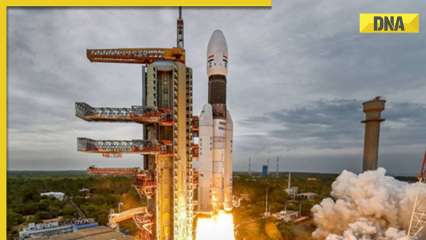Did you know ISRO’s mighty rocket weighs equal to 130 elephants, is taller than Qutub Minar?
India’s space milestone continues as Chandrayaan-3 successfully launches on a powerful rocket and will take around a month to reach the moon.
India’s space mission, Chandrayaan-3, successfully launched by the mighty rocket, which also successfully launched Chandrayaan-2 over three and a half years ago. The rocket is an impressive feat of engineering, both in size and capability. It stands tall, wide, and long, requiring a complete upward gaze to take in its entirety. Developed by India’s own Indian Space Research Organisation (ISRO), this rocket is truly special.
With a weight of 642 tonnes, equivalent to the combined weight of 130 elephants, the rocket lives up to its name. Its height surpasses that of the iconic Qutub Minar, reaching a towering 43.5 meters, akin to a 15-story building. ISRO has successfully executed numerous missions with this remarkable creation.
Formally known as the Geosynchronous Standing Satellite Launch Vehicle Mark 3 (GSLV Mk3), ISRO scientists affectionately refer to it as ‘Bahubali’. The rocket is also denoted as LVM3 M4 and operates on specialized fuel, unlike conventional petrol or diesel. It will carry the Chandrayaan spacecraft, weighing approximately 3.9 tonnes, to the lunar orbit.
Key Features of the Rocket:
• It is the most powerful indigenous launcher ever created.
• It boasts a record-breaking weight of 642 tonnes.
• With a towering height of 43.3 meters, it surpasses even the Qutub Minar.
• It has the capacity to lift a 4-tonne satellite into space and a 10-tonne satellite into low Earth orbit.
• The rocket features the powerful cryogenic engine C25, powered by CE-20.
• It incorporates S200 rocket boosters, developed at the Vikram Sarabhai Space Center, providing an extraordinary launch capability.
• GSLV Mk3 has been successfully launched in different models three times to date.
• LVM3 is a three-stage vehicle comprising two solid strap-on motors (S200), a liquid core stage (L110), and a high-thrust cryogenic upper stage (C25).
• When launching heavy communication satellites, this rocket ensures their successful deployment, traversing 180×36,000 km in just 974 seconds.
• ISRO first sent this rocket into space for testing purposes in 2014, marking a new era in the organization’s space missions. Subsequent modifications were made, resulting in a total cost of around Rs 155 crore.
As Chandrayaan-3 embarks on its journey, the rocket stands as a symbol of India’s prowess in space exploration, promising to continue ISRO’s legacy of successful missions and groundbreaking achievements.
Read more: Meet Rakesh Sharma, India’s first astronaut who went to space and made history

India’s space milestone continues as Chandrayaan-3 successfully launches on a powerful rocket and will take around a month to reach the moon.
India’s space mission, Chandrayaan-3, successfully launched by the mighty rocket, which also successfully launched Chandrayaan-2 over three and a half years ago. The rocket is an impressive feat of engineering, both in size and capability. It stands tall, wide, and long, requiring a complete upward gaze to take in its entirety. Developed by India’s own Indian Space Research Organisation (ISRO), this rocket is truly special.
With a weight of 642 tonnes, equivalent to the combined weight of 130 elephants, the rocket lives up to its name. Its height surpasses that of the iconic Qutub Minar, reaching a towering 43.5 meters, akin to a 15-story building. ISRO has successfully executed numerous missions with this remarkable creation.
Formally known as the Geosynchronous Standing Satellite Launch Vehicle Mark 3 (GSLV Mk3), ISRO scientists affectionately refer to it as ‘Bahubali’. The rocket is also denoted as LVM3 M4 and operates on specialized fuel, unlike conventional petrol or diesel. It will carry the Chandrayaan spacecraft, weighing approximately 3.9 tonnes, to the lunar orbit.
Key Features of the Rocket:
• It is the most powerful indigenous launcher ever created.
• It boasts a record-breaking weight of 642 tonnes.
• With a towering height of 43.3 meters, it surpasses even the Qutub Minar.
• It has the capacity to lift a 4-tonne satellite into space and a 10-tonne satellite into low Earth orbit.
• The rocket features the powerful cryogenic engine C25, powered by CE-20.
• It incorporates S200 rocket boosters, developed at the Vikram Sarabhai Space Center, providing an extraordinary launch capability.
• GSLV Mk3 has been successfully launched in different models three times to date.
• LVM3 is a three-stage vehicle comprising two solid strap-on motors (S200), a liquid core stage (L110), and a high-thrust cryogenic upper stage (C25).
• When launching heavy communication satellites, this rocket ensures their successful deployment, traversing 180×36,000 km in just 974 seconds.
• ISRO first sent this rocket into space for testing purposes in 2014, marking a new era in the organization’s space missions. Subsequent modifications were made, resulting in a total cost of around Rs 155 crore.
As Chandrayaan-3 embarks on its journey, the rocket stands as a symbol of India’s prowess in space exploration, promising to continue ISRO’s legacy of successful missions and groundbreaking achievements.
Read more: Meet Rakesh Sharma, India’s first astronaut who went to space and made history
